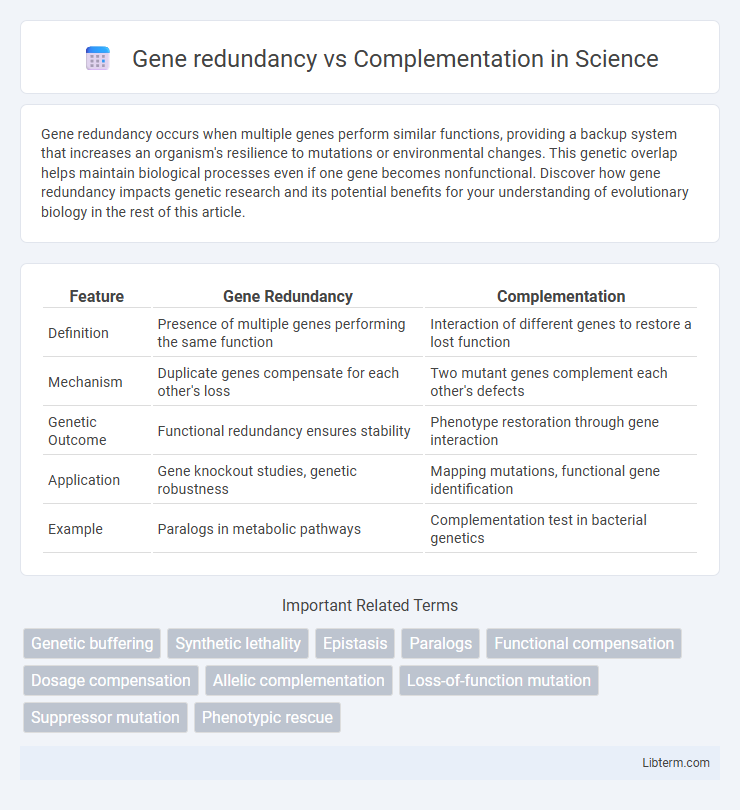Gene redundancy occurs when multiple genes perform similar functions, providing a backup system that increases an organism's resilience to mutations or environmental changes. This genetic overlap helps maintain biological processes even if one gene becomes nonfunctional. Discover how gene redundancy impacts genetic research and its potential benefits for your understanding of evolutionary biology in the rest of this article.
Table of Comparison
| Feature | Gene Redundancy | Complementation |
|---|---|---|
| Definition | Presence of multiple genes performing the same function | Interaction of different genes to restore a lost function |
| Mechanism | Duplicate genes compensate for each other's loss | Two mutant genes complement each other's defects |
| Genetic Outcome | Functional redundancy ensures stability | Phenotype restoration through gene interaction |
| Application | Gene knockout studies, genetic robustness | Mapping mutations, functional gene identification |
| Example | Paralogs in metabolic pathways | Complementation test in bacterial genetics |
Understanding Gene Redundancy
Gene redundancy occurs when multiple genes perform overlapping functions, ensuring that a mutation in one gene does not result in a loss of function due to compensation by another gene. Understanding gene redundancy is crucial for studying genetic robustness and phenotypic stability, as redundant genes can mask the effects of deleterious mutations and contribute to evolutionary adaptability. This concept contrasts with complementation, where different mutations in separate genes can restore function when combined, highlighting distinct genetic interactions.
The Concept of Genetic Complementation
The concept of genetic complementation involves the phenomenon where two different mutations in the heterozygous state produce a wild-type phenotype, indicating that the mutations affect different genes. Gene redundancy, by contrast, occurs when multiple genes perform the same function, so a mutation in one gene may be masked by the presence of another functional gene. Understanding genetic complementation is crucial for mapping gene functions and analyzing genetic pathways in biological systems.
Historical Perspectives in Genetic Research
Gene redundancy and complementation have been pivotal concepts since the early 20th century when geneticists first observed mutations that failed to produce expected phenotypes due to overlapping gene functions. Classical experiments by Beadle and Tatum on Neurospora crassa established the one gene-one enzyme hypothesis, highlighting how gene redundancy could mask mutations, while complementation tests developed by Sturtevant provided a tool to determine if different mutations affected the same gene locus. These foundational studies laid the groundwork for understanding genetic pathways and the intricate relationships between alleles, advancing molecular genetics and functional genomics.
Mechanisms Underlying Gene Redundancy
Gene redundancy arises when multiple genes encode for the same or similar functions, providing a buffer against deleterious mutations by compensating for each other's loss. This mechanism often involves paralogous genes originating from gene duplication events, which maintain overlapping expression patterns and functional domains. Redundancy ensures phenotypic robustness by enabling genetic networks to sustain biological processes through functional complementation among redundant genes.
Types of Genetic Complementation
Gene redundancy occurs when multiple genes perform the same function, masking the effect of a mutation in one gene. Types of genetic complementation include intragenic complementation, where mutations within the same gene complement each other by producing a functional protein complex, and intergenic complementation, involving mutations in different genes within the same pathway that restore function when combined. Complementation tests help distinguish between allelic mutations (intragenic) and mutations in separate genes (intergenic), crucial for genetic pathway mapping and functional genomics.
Experimental Approaches to Distinguish Redundancy and Complementation
Experimental approaches to distinguish gene redundancy and complementation include functional assays, such as gene knockout or knockdown studies, which observe phenotypic outcomes when individual or multiple genes are inactivated. Complementation tests using mutant strains help determine whether different genes restore a phenotype by compensating for each other's loss, indicating complementation rather than redundancy. Advanced methods like CRISPR-Cas9 multiplex genome editing facilitate simultaneous targeting of gene families, enabling differentiation between redundant gene functions and true genetic complementation in complex biological pathways.
Gene Redundancy and Evolutionary Significance
Gene redundancy occurs when multiple genes perform similar or overlapping functions, providing a genetic backup that enhances organismal robustness against deleterious mutations. This redundancy allows for evolutionary experimentation, as redundant gene copies can accumulate mutations without causing immediate fitness consequences, potentially leading to novel gene functions or increased complexity. The evolutionary significance of gene redundancy lies in its role in promoting genetic diversity, facilitating adaptation, and buffering against environmental stresses and genetic perturbations.
Functional Implications in Health and Disease
Gene redundancy provides a genetic backup system where multiple genes can perform similar functions, ensuring cellular resilience against mutations and reducing the risk of disease. Complementation occurs when two different defective genes compensate for each other's loss, restoring normal function and highlighting potential pathways for therapeutic intervention. Both mechanisms play critical roles in maintaining biological homeostasis and can influence the progression and treatment of genetic disorders.
Applications in Genetic Engineering and Biotechnology
Gene redundancy enhances genetic stability by providing backup copies of essential genes, reducing the impact of mutations in genetic engineering. Complementation enables functional restoration by combining mutated genes with wild-type counterparts, facilitating precise gene function analysis and synthetic biology applications. These mechanisms are crucial for developing robust genetically modified organisms (GMOs) and optimizing metabolic pathways in biotechnology for improved production yields.
Future Directions in Gene Redundancy and Complementation Studies
Future directions in gene redundancy and complementation studies emphasize advanced genome editing tools like CRISPR-Cas9 to systematically dissect redundant gene functions and uncover compensatory pathways. High-throughput functional genomics and single-cell RNA sequencing are pivotal for mapping gene interaction networks and identifying subtle phenotypic effects of gene knockouts. Integration of multi-omics data with computational modeling will accelerate the prediction of redundancy mechanisms and guide synthetic biology applications for therapeutic gene target optimization.
Gene redundancy Infographic

 libterm.com
libterm.com